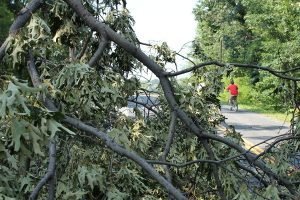 [/frame]I missed the most recent big weather event in Virginia, the wall of wind storms that swept through several states, tearing down trees and power lines. As a child spending summers in the Mississippi Delta I was always perplexed when my uncle and aunt, cotton and soy bean farmers, would demand immediate quiet the minute the weather report came on the TV. A solemn silence, an almost sacred dread and expectation, filled the room. In recent visits, I have noticed a square computer like machine, called a data transmission network that relays weather pattern information—rain, high and low temperatures, short and long-ranged forecasts, storm watches and warnings. The small flecks of colors, the spectrum—light, medium and dark greens communicate light, medium, and heavy rain, the yellows, oranges and reds even heavier to severe storms, and the white for hail.
[/frame]I missed the most recent big weather event in Virginia, the wall of wind storms that swept through several states, tearing down trees and power lines. As a child spending summers in the Mississippi Delta I was always perplexed when my uncle and aunt, cotton and soy bean farmers, would demand immediate quiet the minute the weather report came on the TV. A solemn silence, an almost sacred dread and expectation, filled the room. In recent visits, I have noticed a square computer like machine, called a data transmission network that relays weather pattern information—rain, high and low temperatures, short and long-ranged forecasts, storm watches and warnings. The small flecks of colors, the spectrum—light, medium and dark greens communicate light, medium, and heavy rain, the yellows, oranges and reds even heavier to severe storms, and the white for hail.
Nowadays this information can be pulled up on a cell phone but no one talks about the weather like a farmer. I have decided I do like to think about weather. I listen to a farmer talk of thunderstorms topping out (rain), or downdraft air hitting the ground, pushing out heat and moisture, lifting up into the smaller clouds ahead of the main storm, or how the storm feeds on itself. I know my cousin walks outside to look at the clouds to see if they are building up and where. Is it in the east? In Mississippi rain seldom comes from that direction—or the north, west, or south? But regardless of the dramatic and concrete language of storms, nobody wants to suffer through them. I was not a witness to the derecho, but Mel Jones who had planned to spend her vacation writing, did experience the destructive winds. She blogs about her experience living through the derecho and its aftermath.
-Trudy Hale, co-editor in chief
Follow us!Share this post with your friends.
